Dive & Stay - Tobago
Stay in land based accommodations in Tobago with guided SCUBA dives. Limited time offer.
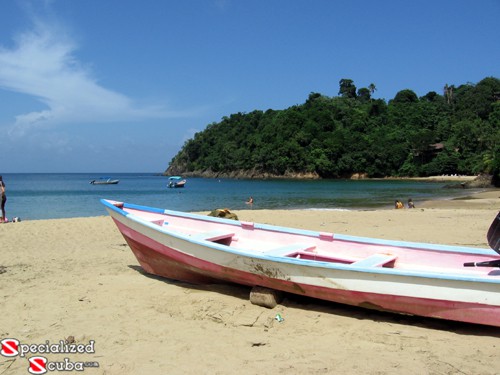 | Overview Itinerary |
Overview
Location
Tobago (pronounced tuh-BAY-go) is the smaller of the two principal islands that make up the Republic of Trinidad and Tobago. Trinidad and Tobago are at the far Southeastern end of the Caribbean Sea, sometimes considered part of the Windward Islands of the Lesser Antilles also know as the West Indies.
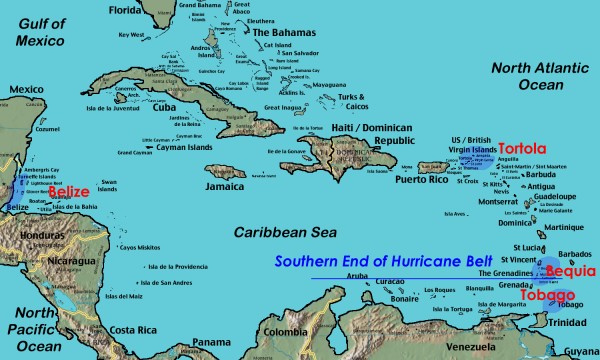
Hurricane Belt
Whether you travel plans call for peak or low season travel, Tobago is an ideal destination as Tobago's location is below the Southern end of the Hurricane Belt.
As depicted on the map, the only places in the Caribbean that are not in the hurricane belt are the islands of Barbados, Trinidad and Tobago, Bonaire, Curacao, Aruba, Providencia Island, San Andres, Panama, and the islands off Venezuela.
This is particularly good for off season travel, since low season corresponds with hurricane season making Tobago a safe destination for discounted travel bargains.
Geography
Tobago is about 26 miles long and 6 miles wide with a population of about 54,000.
Tobago is primarily hilly and of volcanic origin. The southwest of the island is flat and consists largely of coralline limestone. The hilly spine of the island rises to the highest point in Tobago, Pigeon Peak (1804 ft) near Speyside.
There are also smaller islands off of Tobago:
Little Tobago - Northeast of the village of Speyside the island supports dry forest. It is an important breeding site for seabirds such as Red-billed Tropicbird, Audubon's Shearwater, Brown Booby, Brown Noddy, Sooty and Bridled Terns. A few pairs of White-tailed Tropicbirds have also recently started nesting here. Little Tobago is also a good site from which to see birds which breed on neighboring small islands, including Red-footed Booby and Magnificent Frigate bird. The latter species is frequently seen harassing the tropicbirds, boobies and terns. The sea between Speyside and Little Tobago is shallow, and glass-bottomed boats are popular for viewing and snorkeling. There are numerous scuba diving sites located in front of and around Goat Island.
St. Giles Island - Located at the Northern most tip of Tobago is a popular dive destination for the dives sites known as Marble island, St. Giles and London Bridge. Being at the point where the Atlantic and Caribbean meet, there are currents and waves that affect both the sailing and the diving.
Goat Island - It is located off the coast of Speyside, between Tobago and Little Tobago. It is most notable as the former home and retreat of Ian Fleming, the author and creator of the James Bond series
Sisters' Rock - Located on the Northwestern side of Tobago, these rocks are popular dive destinations for private charters, but are generally too far to reach for typical dive boats.
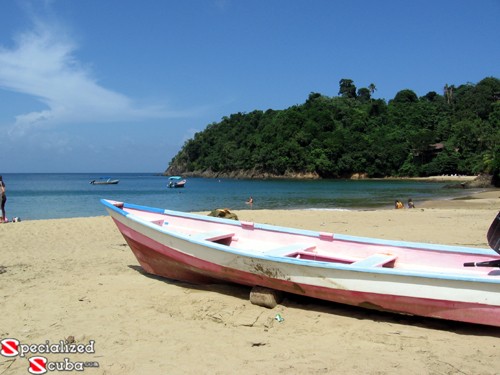 These 4 islands off of main island of Tobago are popular ecological and scuba dive destinations. The 3 and 5 day Tobago Dive Safaris offer Sailing and Diving opportunities to all of these islands that can be enjoyed in conjunction with a SailDivesTM excursion, or as separate excursions with any visit to Tobago.
These 4 islands off of main island of Tobago are popular ecological and scuba dive destinations. The 3 and 5 day Tobago Dive Safaris offer Sailing and Diving opportunities to all of these islands that can be enjoyed in conjunction with a SailDivesTM excursion, or as separate excursions with any visit to Tobago.
Economy and Tourism
The principal economic forces specific to Tobago are tourism and government spending. Conventional beach and water-sports tourism is largely focused in the south-west around the airport and the coastal strip; however, ecotourism is growing in significance, and much of it is focused on the large area of protected forest in the center and north of the main island and on Little Tobago, a small island off the north east tip of the main island.
Tourism is concentrated in the southwest of the island, around Crown Point, Store Bay, Pigeon Point and Buccoo Reef. This area has large expanses of sand and is dominated by resort type developments. Tobago has many idyllic beaches around its coastline, especially those at Castara, Bloody Bay, and Englishman's Bay.
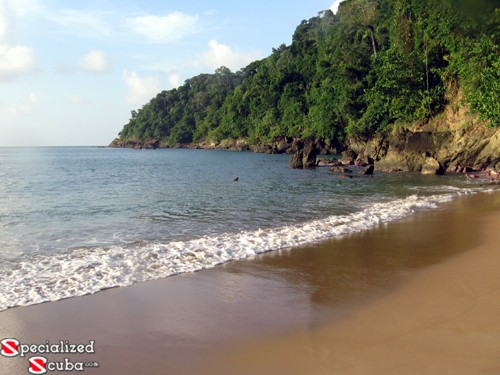
Tobago is linked to the world through the Crown Point International Airport and the Scarborough harbor Domestic flights connect Tobago with Trinidad, and international flights connect with the Caribbean and Europe. There is also a daily fast ferry service between Port of Spain and Scarborough.
Beach in West coast of Tobago The island of Tobago is also thought to be the island that the story Robinson Crusoe was written about. However, the book is probably based on some of the experiences of Alexander Selkirk, who was marooned in the Pacific's Juan Fernandez Islands.
This island was also the filming location for the Walt Disney movie The Swiss Family Robinson.
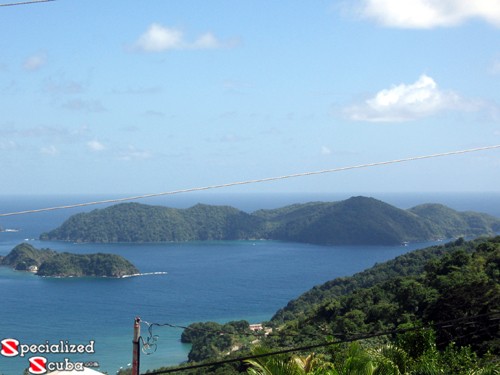
Diving
Tobago is also a popular diving location, since it is the most southerly of the Caribbean islands which have coral communities. Trinidad, which is further south, has no significant coral because of low salinity and high silt content, the result of its position close to the mouth of Venezuela's Orinoco River. Scuba diving on Tobago tends to be centered at Speyside, almost diametrically across the island from the airport.
The island has some of the best diving sites in the Caribbean. There are three wrecks located around its shores, but the one usually considered the best is the Maverick Ferry, which used to travel between Trinidad and Tobago. The ferry is 350 feet long and has been sunk in 30 meters/100 feet just off Rocky Point, Mt. Irvine. The top of the wreck is at 15 meters/50 feet. The wreck has an abundance of marine life, including a 4-foot jewfish, a member of the grouper family. The wreck was purposely sunk for divers, and so all the doors and windows were removed.
The waters around the island are home to many species of tropical fish, rays, sharks, and turtles.
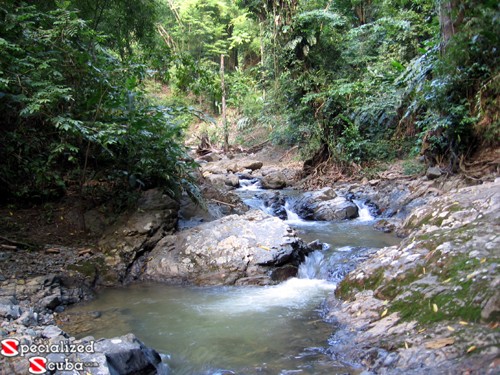
Ecology
The Tobago Forest Reserve (or the Main Ridge Reserve) claims to be the oldest protected forests in the Western world. It was designated as a protected Crown Reserve on April 17, 1776 following representations by Soame Jenyns a Member of Parliament in Britain who had the responsibility for the development of Tobago. It has remained a protected area ever since.
This forested area has great biodiversity including many species of birds, mammals, frogs, (nonpoisonous) snakes, butterflies and other invertebrates. It is one of the most approachable areas of rainforest, since it is relatively small and there are government- appointed guides who provide an authoritative guiding service through the forest at a reasonable cost. The guides are knowledgeable about the plants and the animals, and can call down rare and exotic birds from the canopy by imitating their calls.
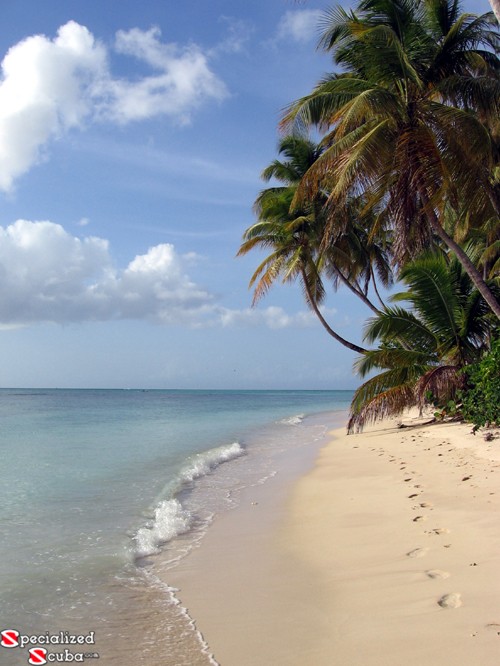 Little Tobago, the small neighboring island, supports some of the best dry forest remaining in Tobago. Little Tobago and St. Giles Island are important seabird nesting colonies, with Red-billed Tropicbird, Magnificent Frigate bird and Audubon's Shearwater amongst others.
Little Tobago, the small neighboring island, supports some of the best dry forest remaining in Tobago. Little Tobago and St. Giles Island are important seabird nesting colonies, with Red-billed Tropicbird, Magnificent Frigate bird and Audubon's Shearwater amongst others.
Climate
Daytime temperatures ranges for lows and highs consistently average between 70F/86F in January to March and 75F/90F throughout the rest of the year. Tradewinds bring cooling breezes for most of the year. The warmer, summer months of May to November are a welcome mixture of cooling showers, sunshine and light breezes, with the occasional heavy downpour.
Water temperature is steady year round and averages 82F so no need for divers to bring wetsuits. However, there may be thermals to 76F, so you may want to bring a shortie.




